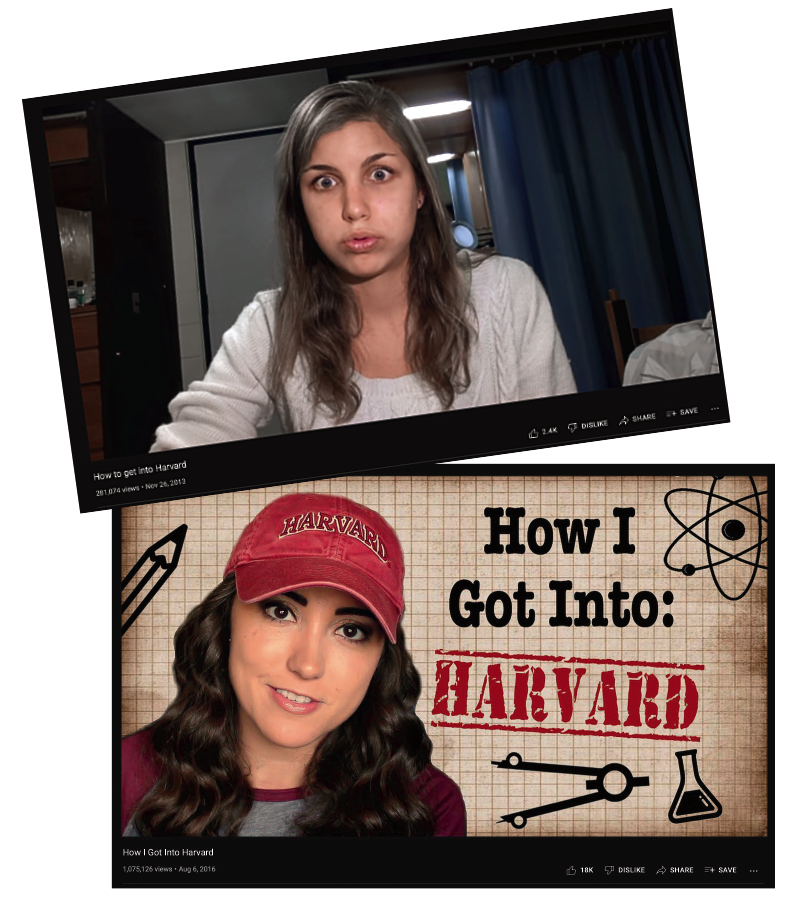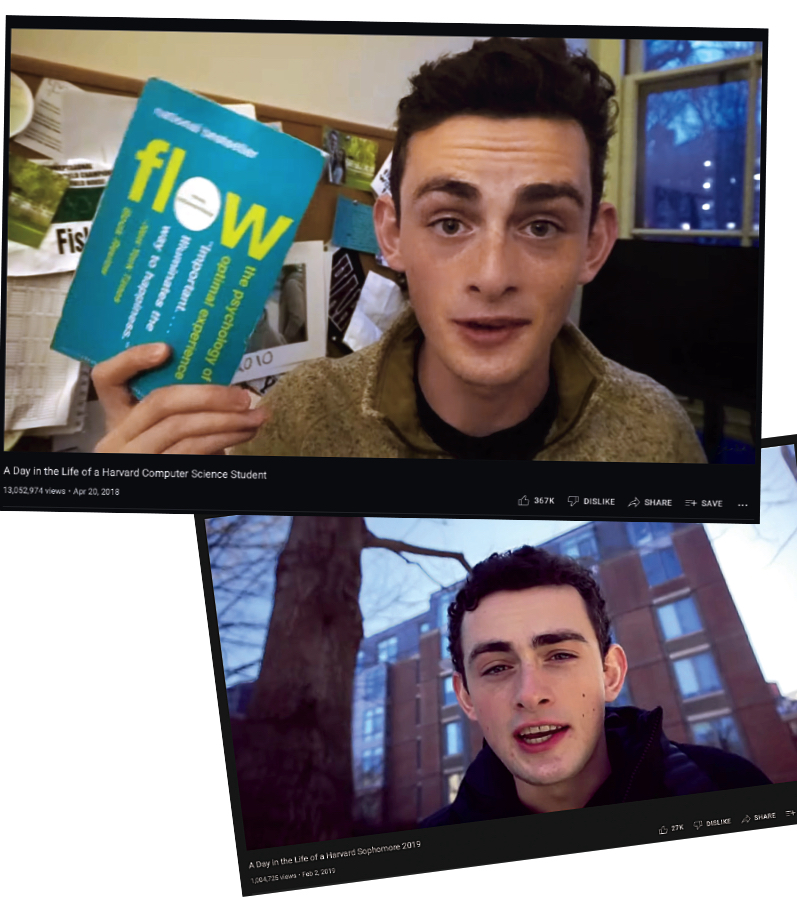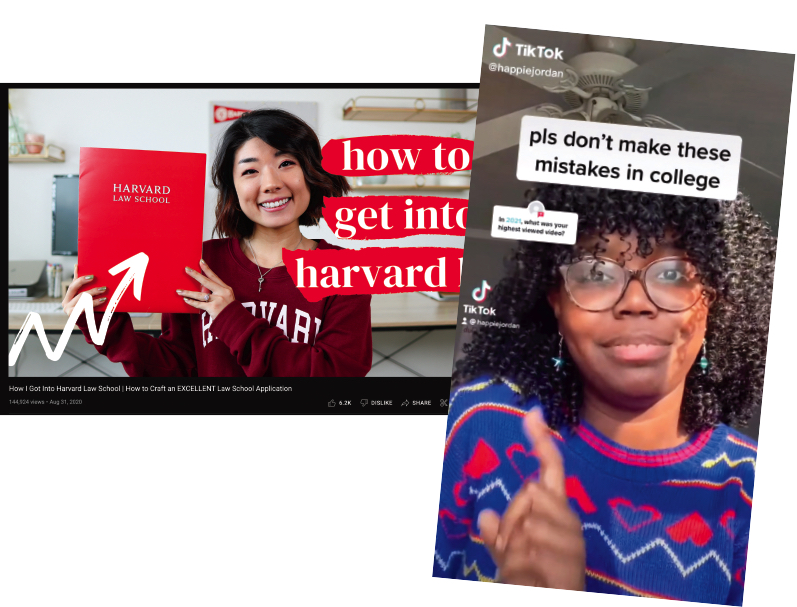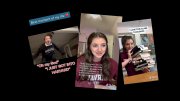Abigail Mack ’25 didn’t set out to become a minor internet celebrity; she just responded to a trend. Every year, thousands of high-school students post “reaction videos” of their getting accepted, waitlisted, or rejected from colleges. The more competitive the colleges applied to, the more explosive the reactions, and the more views the video gets. Mack had enjoyed watching these reactions throughout high school and knew she was going to make her own video before she had even applied.
Mack got a “status update” email from Harvard in late March 2020—a month before Ivy League decisions were due. Though she assumed the College was just requesting a missing piece of financial or academic information, she recorded herself checking her application status just in case. Mack gasped, then leapt into the air. “Oh my God!” she yelled. “I just got into Harvard! Dad, I just got into Harvard!” She tried reading the letter aloud at her father’s request, but her stream of words was barely comprehensible, the elation too much.
She posted the scene to the video-sharing app TikTok, guessing that the prominence of the Harvard name and her joyful reaction could draw a larger audience than usual. “All of a sudden, instead of having 23 views on a video, I had 40,000,” she recalled. And her thousands of new viewers wanted to know how she had gotten in: what were her test scores, extracurricular activities? And what advice did she have for applicants? Mack began posting video responses to these questions, each of which got thousands of views. Within weeks, she had a devoted following of about 10,000 people.
The one part she hesitated to share was her Common Application essay, about the loss of her mother to cancer when she was 12. She wasn’t sure she wanted the story out in the world, nor did she want cynical people writing that she was “using” tragedy to get into college. She instead posted a video describing what the essay was about—cramming her schedule with activities to avoid processing the loss—without getting into the details. But when her followers encouraged her to post the whole thing, she decided to do so.
“I hate the letter ‘S,’” she began. “Of the 164,888 words with ‘S,’ I only grapple with one. To condemn an entire letter because of its use .0006 percent of the time sounds statistically absurd, but that one case changed 100 percent of my life. I used to have two parents, but now I have one, and the ‘S’ in ‘parents’ isn’t going anywhere.”
She posted the video on a Monday night around 6:00. An hour later, it had about 13,000 views—about what she had expected from her small, dedicated audience. When she finished dance class, it had 100,000. By the time she returned home, it had 200,000. After homework, 1,000,000. In the morning, 8,000,000.
Today, the video has been viewed about 20,000,000 times and Mack has more than 160,000 TikTok followers. She’s one of several past or present Harvard students with large social-media followings whose online identities—and origin of their online success—are tied closely to Harvard. As they navigate their lives on campus, figuring out what Harvard is all about, they have thousands of people watching who wonder the same thing.
Looking behind the Curtain
Audiences have long been intrigued by Harvard. The financial success of movies like Love Story (1970), The Paper Chase (1973), Good Will Hunting (1997), and The Social Network (2010) attest to the University’s cultural cachet—and expand its popularity in the process. But while these movies play on the Harvard experience, they don’t try to capture it in earnest; incoming law students don’t watch Legally Blonde (2001)for its insight into campus life.
Since the invention of YouTube in 2005, however, this lack of access began to shift. In 2007, the campus sketch-comedy group On Harvard Time began posting satirical interviews with students, professors, and bystanders. Though not the purpose of the videos, they gave viewers a look at the campus and an insight into students’ senses of humor. YouTube was seen as amateurish at the time, not a serious way to produce films or make money. “[I]f I’m producing YouTube videos professionally in five years,” wrote On Harvard Time editor Sean Goller ’12 in a Crimson essay, “here’s written permission to punch me in the face.”
When Hanna Evensen ’16 began making YouTube videos as a first-year student in 2012, she had no illusions of grandeur. Now an attorney living in Boston, she posted her first video, a comedy riff on Mitt Romney, M.B.A ’74, J.D. ’75, at the recommendation of her roommate. Evensen enjoyed making it, so she filmed a few more quick rants throughout the year. “I thought people were going to think that it was really weird,” she said. “I remember thinking, ‘Is this even allowed?’ I almost thought some administrator was going to say, ‘Hey, you can’t do that.’” But it was her first Harvard-specific video that took off, a gag about “Harvard stereotypes” in which she recommended that aspiring students bribe their admissions officer with cash, card, or check. Her sporadic, no-budget videos filled a need that she hadn’t considered: people worldwide wanted a glimpse into the College. Evensen, sitting in front of a brick wall, recording with her low-quality laptop webcam, was providing it.
When Taylor Reneau ’16 began making videos as a sophomore, she used Evensen’s as a loose guide. Though Evensen’s “How to Get into Harvard” video was satirical, Reneau saw how many viewers it attracted and made a more serious version. It quickly became her most popular video, besting even “Rejected from Stanford, Accepted to Harvard.” Though she posted non-Harvard content as well, viewers responded much more to Harvard videos: an inside look on Housing Day, a question-and-answer session with a student, a review of the College’s financial-aid policy. Eventually she created a paid digital guide for people applying to Ivy League schools, which still earns her about $1,000 a month in passive income. Those who sign up often know about Harvard but little about the environment around it. “Ivy League, they don’t know.…Columbia, Yale, they don’t know. But Harvard, that brand name is insane,” Reneau said. “And what I found interesting is that they’ll know the brand name, but they won’t know anything about the school, and they’ll have all these assumptions about what Harvard students are like.”
The Allure of Crimson Life
The video landscape has changed. Harvard students, who grew up with YouTube, have witnessed it launch some of society’s most popular singers, comedians, and celebrities. (In a survey from Harris polls and the LEGO company, 29 percent of children eight to 12 years old aspired to be a YouTuber, a greater share than any other profession.) Many students arrive on campus intending to make YouTube or TikTok a significant part of their campus experience, and know what kind of videos draws in the most viewers: “A day in the life of a Harvard student,” “How to get into Harvard,” “Why I chose Harvard,” “Harvard dorm tour.” For students who want to break into content creation—potentially earning a six-figure annual income (or at least a steady side income) through YouTube advertising revenue and outside brand partnerships—the world’s insatiable appetite for Harvard content is a good starting point.
One of those YouTubers is John Fish ’21 [’22]. Now the most popular YouTube creator on campus, with nearly one million followers on the site, he started posting frequent videos during his final month of high school in Waterloo, Ontario. A fan of Casey Neistat, a YouTuber who posted cinematic daily “vlogs,” Fish thought people might be interested in a similar style of video, “telling the story of what it is like to actually go to Harvard,” as he explained it. “And so that was kind of the initial thesis.”
Fish posted daily the summer before matriculating as he spent time with friends, ran track and field workouts, and discussed coding projects. The most attention came from his Crimson-themed videos “How to Get into Harvard” and “How I Got Into Harvard.” But unrelated videos did well, too, including one where he revealed how much money he was making through his posts (at the time, with about 1,400 subscribers, around $2.50 apiece through YouTube advertising revenue).

Hanna Evensen ’16 (top) inadvertently set a precedent with her low-budget campus films. Many, including Taylor Reneau ’16, followed her example.
Screenshots courtesy of Hanna Evensen’s and Taylor Reneau’s YouTube videos
When Fish got to campus, he stopped posting once a day. “It became pretty clear that wouldn’t be feasible,” he said. After a two-month break during his first semester, he shifted his channel’s primary theme to personal growth ahead of his second: “How I Fight Unproductivity,” “How I Study,” “How To Take Better Notes.” Still, the Harvard connection remained strong. “A Day in the Life of a Harvard Computer Science Student” remains the most popular video posted on his channel, with 12 million views. The video starts with him waking up at 7:00 and drinking tea and ends at 10:00 that evening with him going to bed. In between, he attends Swedish, math, and computer-science classes, eats breakfast, lunch, and dinner, goes to varsity track practice, and reads a one-minute-long paid advertisement for an educational-video website. Like most campus creators, Fish comes across as a highly efficient, worldly Harvard student.
Sienna Santer ’22, a women, gender, and sexuality studies concentrator from San Luis Obispo, California, began making campus videos a year later, in 2018, sharing her move-in experience in a video that now has more than seven million views. “It’s gonna be cozy,” Santer said as she set up her bed that sat just feet from her roommate’s. After finishing her dorm decorations, she took a few minutes to reflect. “It’s kind of insane I’m at Harvard,” she said. “I don’t really believe it yet.” She gave a 26-minute tour of her living space in her next video, which has since reached 1.5 million views. The comment section is filled with requests for more content from viewers around the world: a video explaining expectations vs. realities of being a Harvard student, a day-in-the-life video, more information about her schedule. “I love these videos because it shows being in Harvard doesn’t make you a huge nerd (despite stereotypes),” someone commented. “Students can be cute and trendy even if they go to a school that is known for academics (I don’t even know if this comment makes sense).”
The demand for Harvard content is so strong that students have posted videos for their own use that have garnered hundreds of thousands of views. When Alina Taratorin ’24, a psychology concentrator in Eliot House, moved onto campus alone during the especially sterile fall 2020 COVID-influenced move-in, she recorded a 12-minute video for her parents in Palo Alto, California. By the time she had finished capturing the footage that detailed her flight to Boston, shopping trip to Target, on-campus COVID test, key and meal pick-up, and first dorm entrance, she decided to share with her friends, too. “And then somehow that video just blew up,” she said. Today, it has about 240,000 views.
A Filtered Experience
Through the sheer number of videos filmed at Harvard, viewers across the world have a better sense than ever about what it’s like to be on campus. They can compare and contrast dozens of dorm tours, days in the life, and move-in vlogs, and virtually acquaint themselves with students from a range of backgrounds. On TikTok, they ask how housing works, what students do for fun, what the dining hall food is like. (One anonymous TikTok account that posts occasional reviews of dining-hall food averages more than 100,000 views per video.)
Those interested in attending the College can still check official University resources (a YouTube account run by the admissions office publishes its own student dorm tours, days in the life, and application tips), but they can get more personal and in-depth advice from students and graduates who walk through every aspect of their applications. Some, like Jordan Sanchez ’24, whose TikTok has more than 100,000 followers, offer tips for students who might not have robust advising programs at their high schools—and rarely mention Harvard. (The college-advice niche can be lucrative; Sanchez recalls a brand paying her $2,000 for a 30-second TikTok advertisement.) There are plenty of Harvard Medical School perspectives as well, and even Law School content from Barbara Tsao J.D., ’23, who, after noticing a lack of in-depth information on YouTube, created videos about preparing for the LSAT and crafting a law-school application.
"How can I really do lifestyle content," Mack said after her first semester, "if I don't know my college lifestyle?"
But there’s a counterintuitive aspect to the campus videos: most people creating them are underclassmen with limited knowledge of college life. When Abigail Mack entered Harvard months after her admissions video attracted an audience of millions, she decided to switch the focus of her posts from how to get in, to the College experience itself. It was tough for her to manage. “How can I really do lifestyle content,” Mack said in an interview after her first semester had ended, “if I don’t know my college lifestyle?”
Aggravating this problem was the fact that Mack’s first semester was shaped by her online popularity. She was sometimes recognized away from Harvard, but on campus, most people were familiar with her story. “That was really challenging to deal with because people have this first perception of me just through their screens,” Mack said. “And it was like, ‘Oh my God, wait, you’re the Harvard TikTok girl.’”
With her followers requesting more information about her experience, Mack felt uneasy about describing it. A sort-of celebrity, she had just arrived at Harvard and knew only as much as any student in her first year. Her followers wanted her to broadcast live on TikTok, but she didn’t want her peers thinking, “Oh, the TikTok girl’s out there answering questions like she’s the Harvard authority or something.” When she responded to questions as the semester continued, she tried to qualify her advice and opinions as much as possible. “I’m getting a very, very small portion of the scope and scale of what it means to go to Harvard,” she said.

With nearly one million subscribers, John Fish ’21 is Harvard’s most successful YouTube creator and one of the few who has broken out of the College niche.
Screenshot courtesy of John Fish’s YouTube videos
As John Fish shared his Harvard experience on YouTube during his first year, he too struggled. “It’s just one of those things where you have to sacrifice something,” he said. “And when I was a freshman, the thing that I sacrificed was a social life.” It was a decision he made partly out of insecurity, he said. He had earned a large viewership and he felt pressure to keep it up despite the time commitment. As he relayed his College life to the public, he was missing a significant portion of what, for most people, is crucial to the undergraduate experience.
He was also boxing himself in. The more videos he posted about how he structured his time, studied, and set goals, the more pressure he felt to uphold the image he had created online. “It felt like that was kind of immutable,” he said. “Because when I was a freshman, I said these things, I have to be like that forever.” Adding to the self-imposed pressure was the fact that many of his peers had watched his videos. “I think that’s one of the cool things about college—that you get to invent who you are in these anonymous groups,” he said. “And I do feel like I missed out on part of that because I had this curated image online.”
It took leaving college for a year after his sophomore spring to come to terms with the role video-creation played in his life. Filming at Harvard was unfeasible during his software-engineering internship in Canada, so he made more videos on programming, reading, and productivity. With more time to think about his posts, he escaped the classic trap for College creators, where viewers care almost exclusively about their connection to Harvard—and stop watching once they stop talking about it. He also found a healthier balance between YouTube success and his life, realizing that he was happier when YouTube was a passion project rather than his primary source of income.
While Fish appreciates that platforms like YouTube and TikTok allow for a more authentic view of Harvard than presented in movies and on television, he acknowledges the limits. “I just think there’s this superhuman perception that people try to put out,” he said. “I’m one of those people, or I’ve been one of those people—it’s really hard to avoid, and it’s really easy to criticize from the outside. But when you’re showing off your life, you say, ‘I don’t want to show off that I’m not doing this reading or not doing this homework. I want to show off that I’m doing everything and I’m handling it all.’” Mack shares the sentiment. “I try to be as authentic as I can on [TikTok],” she said, “But of course, there is some filtering, even just for my own sanity of not wanting to share every single aspect of my life and my personality.…My friends joke that my TikTok voice is my Disney princess voice.”
Shutting Down—or Branching Out
For many Harvard students who make videos, it’s a couple years and done, if that. By the time students read through their college essays, discuss their extracurricular activities, and tell people how to get into the College, they decide not to continue. Some come in intending to post frequently when they arrive on campus, share a few videos, and stop completely. Posting high-quality content is time-consuming, and giving college-admissions advice becomes much less exciting once you’ve enrolled. The most successful Harvard YouTube creators, the handful of students who have become popular enough to make a career on the platform, have found themselves a broader niche outside the Harvard bubble. For Fish, it’s reading and productivity. For Santer, lifestyle and fashion.

Barbara Tsao, J.D. ’23, and Jordan Sanchez ’24 use their platforms to advise college and law school applicants.
Screenshot courtesy of Barbara Tsao’s YouTube videos and Jordan Sanchez’s TikTok videos
Abigail Mack, now in her second semester, is not sure how much she’ll post on TikTok as she moves forward, but already it’s shaped the last couple years of her life. After her admissions essay on loss reached millions of people, she was written about in the Boston Globe and Buzzfeed, and featured on CBS. “My essay was about the fact that I didn’t really deal with my loss,” she said, “And so then all of a sudden, I was forced to deal with it. And deal with it in this public setting.” She still receives several messages a day on her social-media accounts—some from people who want her to write their college essays, but many from people processing loss themselves.
“I have the opportunity to make people feel good about something or to feel heard,” she said. “I know that when I was going through the college process, I loved watching college videos.” It’s fun to be on the other side now, creating videos she would have enjoyed as a high schooler.
As for her future plans, she’s taking it week by week. Like most first-year content creators, she’s determined to post more, she said, “But I need to get through the first week of classes to figure out my schedule first.”









